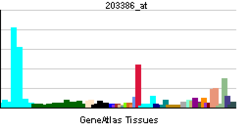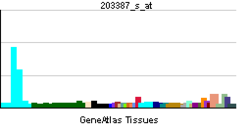- TBC1D4
-
TBC1 domain family, member 4 Identifiers Symbols TBC1D4; AS160; DKFZp779C0666 External IDs OMIM: 612465 MGI: 2429660 HomoloGene: 45451 GeneCards: TBC1D4 Gene Gene Ontology Molecular function • GTPase activator activity
• Rab GTPase activator activityCellular component • intracellular
• cytoplasmSources: Amigo / QuickGO RNA expression pattern 

More reference expression data Orthologs Species Human Mouse Entrez 9882 210789 Ensembl ENSG00000136111 ENSMUSG00000033083 UniProt O60343 n/a RefSeq (mRNA) NM_014832 NM_001081278.2 RefSeq (protein) NP_055647 NP_001074747.2 Location (UCSC) Chr 13:
75.86 – 76.06 MbChr 14:
101.84 – 102.01 MbPubMed search [1] [2] TBC1 domain family member 4 is a protein that in humans is encoded by the TBC1D4 gene.[1][2][3][4]
The 160 kD protein product was first discovered in a screen for novel substrates of the serine-threonine kinase Akt, which phosphorylates AS160 after insulin stimulation.[5] Insulin stimulation of fat and muscle cells results in translocation of the glucose transporter GLUT4 to the plasma membrane, and this translocation process is dependent on phosphorylation of AS160.[6] The role of AS160 in GLUT4 translocation is mediated by its GTPase activating domain and interactions with Rab proteins in vesicle formation, increasing GLUT4 translocation when its GTPase activity is inhibited by Akt phosphorylation. Specifically, this inhibition activates RAB2A, RAB8A, RAB10 and RAB14.[7]
AS160 also contains a calmodulin-binding domain, and this domain mediates phosphorylation-independent glucose uptake in muscle cells.[8]
References
- ^ Kurihara LJ, Semenova E, Miller W, Ingram RS, Guan XJ, Tilghman SM (Feb 2002). "Candidate genes required for embryonic development: a comparative analysis of distal mouse chromosome 14 and human chromosome 13q22". Genomics 79 (2): 154–61. doi:10.1006/geno.2002.6692. PMID 11829485.
- ^ Kane S, Sano H, Liu SC, Asara JM, Lane WS, Garner CC, Lienhard GE (Jun 2002). "A method to identify serine kinase substrates. Akt phosphorylates a novel adipocyte protein with a Rab GTPase-activating protein (GAP) domain". J Biol Chem 277 (25): 22115–8. doi:10.1074/jbc.C200198200. PMID 11994271.
- ^ Matsumoto Y, Imai Y, Lu Yoshida N, Sugita Y, Tanaka T, Tsujimoto G, Saito H, Oshida T (Aug 2004). "Upregulation of the transcript level of GTPase activating protein KIAA0603 in T cells from patients with atopic dermatitis". FEBS Lett 572 (1-3): 135–40. doi:10.1016/j.febslet.2004.07.023. PMID 15304337.
- ^ "Entrez Gene: TBC1D4 TBC1 domain family, member 4". http://www.ncbi.nlm.nih.gov/sites/entrez?Db=gene&Cmd=ShowDetailView&TermToSearch=9882.
- ^ Kane S, Sano H, Liu SC, et al. (2002). "A method to identify serine kinase substrates. Akt phosphorylates a novel adipocyte protein with a Rab GTPase-activating protein (GAP) domain". J. Biol. Chem. 277 (25): 22115–8. doi:10.1074/jbc.C200198200. PMID 11994271.
- ^ Sano H, Kane S, Sano E, et al. (2003). "Insulin-stimulated phosphorylation of a Rab GTPase-activating protein regulates GLUT4 translocation". J. Biol. Chem. 278 (17): 14599–602. doi:10.1074/jbc.C300063200. PMID 12637568.
- ^ Mîinea CP, Sano H, Kane S, et al. (2005). "AS160, the Akt substrate regulating GLUT4 translocation, has a functional Rab GTPase-activating protein domain". Biochem. J. 391 (Pt 1): 87–93. doi:10.1042/BJ20050887. PMC 1237142. PMID 15971998. http://www.pubmedcentral.nih.gov/articlerender.fcgi?tool=pmcentrez&artid=1237142.
- ^ Kramer HF, Taylor EB, Witczak CA, Fujii N, Hirshman MF, Goodyear LJ (2007). "Calmodulin-binding domain of AS160 regulates contraction- but not insulin-stimulated glucose uptake in skeletal muscle". Diabetes 56 (12): 2854–62. doi:10.2337/db07-0681. PMID 17717281.
Further reading
- Nagase T, Ishikawa K, Miyajima N, et al. (1998). "Prediction of the coding sequences of unidentified human genes. IX. The complete sequences of 100 new cDNA clones from brain which can code for large proteins in vitro.". DNA Res. 5 (1): 31–9. doi:10.1093/dnares/5.1.31. PMID 9628581.
- Nakayama M, Kikuno R, Ohara O (2003). "Protein-protein interactions between large proteins: two-hybrid screening using a functionally classified library composed of long cDNAs.". Genome Res. 12 (11): 1773–84. doi:10.1101/gr.406902. PMC 187542. PMID 12421765. http://www.pubmedcentral.nih.gov/articlerender.fcgi?tool=pmcentrez&artid=187542.
- Lee SY, Obata Y, Yoshida M, et al. (2003). "Immunomic analysis of human sarcoma.". Proc. Natl. Acad. Sci. U.S.A. 100 (5): 2651–6. doi:10.1073/pnas.0437972100. PMC 151395. PMID 12601173. http://www.pubmedcentral.nih.gov/articlerender.fcgi?tool=pmcentrez&artid=151395.
- Dunham A, Matthews LH, Burton J, et al. (2004). "The DNA sequence and analysis of human chromosome 13.". Nature 428 (6982): 522–8. doi:10.1038/nature02379. PMC 2665288. PMID 15057823. http://www.pubmedcentral.nih.gov/articlerender.fcgi?tool=pmcentrez&artid=2665288.
- Beausoleil SA, Jedrychowski M, Schwartz D, et al. (2004). "Large-scale characterization of HeLa cell nuclear phosphoproteins.". Proc. Natl. Acad. Sci. U.S.A. 101 (33): 12130–5. doi:10.1073/pnas.0404720101. PMC 514446. PMID 15302935. http://www.pubmedcentral.nih.gov/articlerender.fcgi?tool=pmcentrez&artid=514446.
- Jin J, Smith FD, Stark C, et al. (2004). "Proteomic, functional, and domain-based analysis of in vivo 14-3-3 binding proteins involved in cytoskeletal regulation and cellular organization.". Curr. Biol. 14 (16): 1436–50. doi:10.1016/j.cub.2004.07.051. PMID 15324660.
- Karlsson HK, Zierath JR, Kane S, et al. (2005). "Insulin-stimulated phosphorylation of the Akt substrate AS160 is impaired in skeletal muscle of type 2 diabetic subjects.". Diabetes 54 (6): 1692–7. doi:10.2337/diabetes.54.6.1692. PMID 15919790.
- Kim JE, Tannenbaum SR, White FM (2005). "Global phosphoproteome of HT-29 human colon adenocarcinoma cells.". J. Proteome Res. 4 (4): 1339–46. doi:10.1021/pr050048h. PMID 16083285.
- Beausoleil SA, Villén J, Gerber SA, et al. (2006). "A probability-based approach for high-throughput protein phosphorylation analysis and site localization.". Nat. Biotechnol. 24 (10): 1285–92. doi:10.1038/nbt1240. PMID 16964243.
- Treebak JT, Birk JB, Rose AJ, et al. (2007). "AS160 phosphorylation is associated with activation of alpha2beta2gamma1- but not alpha2beta2gamma3-AMPK trimeric complex in skeletal muscle during exercise in humans.". Am. J. Physiol. Endocrinol. Metab. 292 (3): E715–22. doi:10.1152/ajpendo.00380.2006. PMID 17077344.
- Olsen JV, Blagoev B, Gnad F, et al. (2006). "Global, in vivo, and site-specific phosphorylation dynamics in signaling networks.". Cell 127 (3): 635–48. doi:10.1016/j.cell.2006.09.026. PMID 17081983.
- Ewing RM, Chu P, Elisma F, et al. (2007). "Large-scale mapping of human protein-protein interactions by mass spectrometry.". Mol. Syst. Biol. 3 (1): 89. doi:10.1038/msb4100134. PMC 1847948. PMID 17353931. http://www.pubmedcentral.nih.gov/articlerender.fcgi?tool=pmcentrez&artid=1847948.
- Howlett KF, Sakamoto K, Garnham A, et al. (2007). "Resistance exercise and insulin regulate AS160 and interaction with 14-3-3 in human skeletal muscle.". Diabetes 56 (6): 1608–14. doi:10.2337/db06-1398. PMID 17369524.
- Frøsig C, Rose AJ, Treebak JT, et al. (2007). "Effects of endurance exercise training on insulin signaling in human skeletal muscle: interactions at the level of phosphatidylinositol 3-kinase, Akt, and AS160.". Diabetes 56 (8): 2093–102. doi:10.2337/db06-1698. PMID 17513702.
Categories:- Human proteins
- Chromosome 13 gene stubs
Wikimedia Foundation. 2010.
